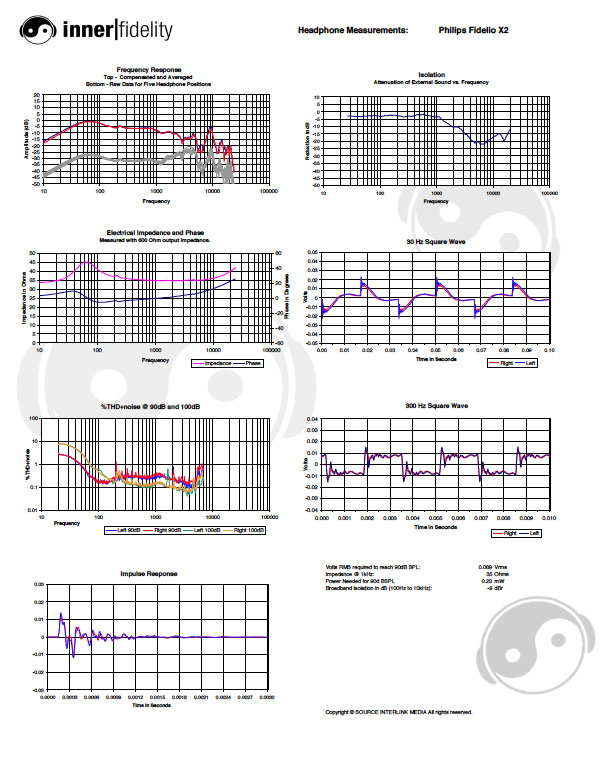| Columns Retired Columns & Blogs |
Like a Boss: The Philips Fidelio X2 Measurements

Click on graphs image to download .pdf for closer inspection.
Raw frequency response plots for the X2 show a headphone that is very immune to positional changes effecting sound quality. Even the high frequencies show very little change.
Compensated frequency response plots show a headphone with an overall modest warm tilt. Primary driver resonance is shown by the peak at 60Hz with a 12dB/octave roll-off below, which is natural for an open, dynamic headphone.
Though a little bumpy and having a warm tilt, the response from 60Hz to about 5.5kHz is essentially a straight line. Even though it get substantially more noisy, the response above 5.5kHz also does a goos job of following the line established. Take a good hard look at this tilt, I think it may represent something very close to what I would consider neutral.
There is a substantial notch between 5-9kHz. This notch was established as a target response during the development of the X2 in blind tests by highly qualified listeners. I did here the X1 as being a bit more edgy than the X2; the smoother sound of the X2 might indeed be the result of this notch.
30Hz square wave response shows a significant sway-back due to the loss of low bass and phase changes as the driver goes below its primary resonance at 60Hz. Coupled with the related rise in low frequency distortion in the THD plots I would have expected a looser sounding bass response than that which I heard in listening. In email exchanges with the Philips engineer I was told that the trick here is to not overemphasize the bass too much as the looseness will become apparent rapidly at some point. I did hear the bass as slightly loose, but no where near what I would have expected from these measurements.
300Hz square wave response has good shape—first overshoot is about the right magnitude; signal achieves a generally flat top quickly—but there is significant raggedness seen, which is also observed in the impulse response. Generally, when I see this I tend to think the headphones are going to sound harsh. While I did here a little edginess with these cans I did not hear nearly the amount I expected. And the X1, which exhibits significantly less noise than the X2, sounded edgier to me. I'm not sure I can explain that. Were I to guess, it might be that all the fine tuning of the headphone's frequency response has this sort of effect on its time domain response. Dunno.
Apart from the rise in the bass, THD+noise plots show a relatively low distortion headphone with good power handling until you reach 5kHz. Here again, the tuning needed to create the notch between 5-9kHz may create some distortion by-products. Impedance plots show a nominally 35 Ohm headphone with a rise to 45 Ohms at 60Hz at the primary driver resonance. This bump may cause some bloom in the bass if used with a high output impedance amp like a tube OTL design. I would not recommend these cans for use with these types of amps. I suggest 2 Ohm or less output impedance.
Isolation plot shows a little more attenuation above 1kHz than the average open headphone, but below 1kHz virtually none. This is a headphone for listening in quiet environs.
Other than the general shape of the frequency response plot (which I think might be very good, and I'll be looking for more headphones with a similar response), I find these measurements to be significantly poorer looking than the headphones sound. I suspect Philips may work on getting the time domain responses (300Hz square wave, impulse response) to be a little cleaner, but I have to say again that I found these cans much better sounding than they look on paper.
- Log in or register to post comments




































